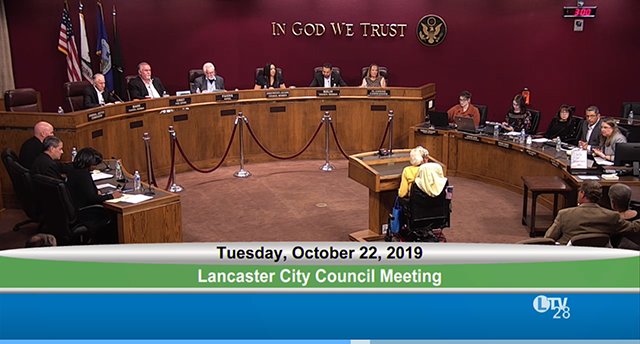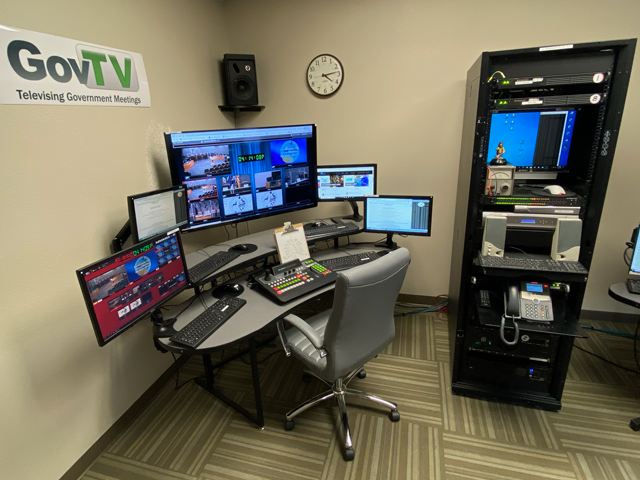 Streaming Media Producer – Aug. 27, 2020 – San Diego-based GovTV never underwent a migration to remote production and streaming—its operations were remote from the get-go. Built to offer flexible, turnkey, scalable, cloud-based, C-SPAN-style live-streamed coverage to government agencies and other organizations holding public meetings, GovTV’s BroadcastManager systems require little more on-site footprint than the one or more mounted, remotely controlled, robotic cameras its clients request.
Streaming Media Producer – Aug. 27, 2020 – San Diego-based GovTV never underwent a migration to remote production and streaming—its operations were remote from the get-go. Built to offer flexible, turnkey, scalable, cloud-based, C-SPAN-style live-streamed coverage to government agencies and other organizations holding public meetings, GovTV’s BroadcastManager systems require little more on-site footprint than the one or more mounted, remotely controlled, robotic cameras its clients request.

Figure 1. Live-streamed Lancaster, Calif., city council meetings pre-COVID-19
Among other regional clients, GovTV has been working with the city of Lancaster, Calif., since 2017, streaming all of its city council meetings (Figure 1, right). The BroadcastManager system is based on technology from Broadcast Pix, which provides live, multiformat switching; customizable multiview; and robotic camera and external device control. Meetings are delivered online through Granicus, a streaming platform expressly designed for streaming government meetings.
Before adopting the Broadcast Pix solution, according to GovTV president and CEO Bob Anderson, “the system that we were using was slow and tired, with a lot of bandwidth issues, and really poor latency.” (In this context, “latency” refers not to streaming-video latency but to delayed response in serial control for robotic PTZ cameras.) “If we didn’t move a camera after about a minute,” Anderson recalls, “the camera would fall asleep. And if we went to that camera, we had to wake it up and then we had to move it. So it was rather cumbersome to say the least in the old system.”
Moving from the older serial control system to an IP-based infrastructure with Broadcast Pix in 2017 made a huge difference in the responsiveness of the system, Anderson says, and it enabled GovTV to do essentially what it set out to do as a company: help local governments that have either inadequate, ad-hoc video coverage or no video program at all to get their meetings online in a reliable and effective manner.
“Some cities, believe it or not, still don’t stream or broadcast their meetings,” Anderson says. “In some cases, it’s a very small system, a couple of cameras on a tripod, and a small switcher somewhere either in the back of the chambers or in a room. So, we’ll come in and put in a whole new system, or just forklift out an old system and replace it. When we put in a BroadcastManager system, we own it, we maintain it 24/7, and the city pays us a license fee. Some cities have a television department, and that works well for them, but other cities really don’t want to be in the business of television/ They’re in the business of government.”

Figure 2. GovTV’s Broadcast Pix-based control room in San Diego
Paul Redfield, founder and president of Orbdot Networks, GovTV’s IT consultant, explains how the BroadcastManager workflow offloads TV-production responsibilities in the Lancaster municipal government to GovTV’s San Diego-based control room: “We have a facility in San Diego. We have the Broadcast Pix cloud infrastructure. And then we have our endpoint, which is in Lancaster. There we have several pieces of equipment, because we are tying into their legacy stuff. We have our cameras there, we have a Broadcast Pix control unit that provides that all the cameras feed into the IP. And we also have our own network here, so we’re not touching any of the city’s network. We connect into Lancaster via a VPN that we manage and maintain with our own hardware, and that’s how we can control and manage the equipment on-site and get confidence feeds back. It allows us to get in and switch on some things manually. We also have a recorder on-prem so we can record the meetings. The Broadcast Pix unit that’s sitting in Lancaster goes into the cloud service that Broadcast Pix provides and then provides us a return feed that we connect to out of San Diego. From that, we get control of the cameras and a multiviewer so we’re able to see all the cameras in real time.”
“Lancaster has a server that their programming comes out of, which is basically a pre-programmed play channel,” adds Jeff Spencer, in-house manager of TV production at GovTV. “When we go to air, we actually have to interrupt their on-air feed, route our signal from the chambers to air, and then, when the meeting’s all over, we have to switch it all back as well. So it’s not just cameras and switchers that are being controlled from our remote location in San Diego. It’s basically everything it takes to get them on and off the air.”
While the shift to working from home over the last 6 months has heightened the demand and the technical requirements for remote production for a lot of outfits, for GovTV, the lack of in-person, on-site meetings has both slowed down and dumbed down its usual operations. “Cities, for the most part, are not doing meetings in their council chambers,” says Anderson. “In the case of Lancaster, now they’re doing Zoom meetings. And so we’re basically just picking up the Zoom feed, and then we broadcast it.”
 “But with our service,” Redfield continues, “we take people out of control rooms. And if you’ve ever seen any city government control rooms, you know they’re usually a closet with two or three people in there”—a problematic proposition in many states under current conditions. “We don’t want to jump in too soon when cities are more in the business of protecting their citizens, but we can offer a service that certainly can help them in this environment.”
“But with our service,” Redfield continues, “we take people out of control rooms. And if you’ve ever seen any city government control rooms, you know they’re usually a closet with two or three people in there”—a problematic proposition in many states under current conditions. “We don’t want to jump in too soon when cities are more in the business of protecting their citizens, but we can offer a service that certainly can help them in this environment.”
By Steve Nathans-Kelly
Streaming Media Producer
Editorial, August 25, 2020
![Broadcast Pix, Inc. [US] Logo](https://broadcastpix.com/wp-content/uploads/2018/05/broadcastpix-inc-sticky-logo7.png)